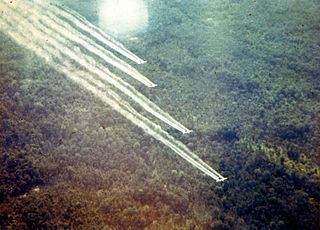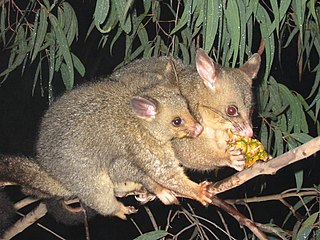Related Research Articles

Herbicides, also commonly known as weed killers, are substances used to control undesired plants, also known as weeds. Selective herbicides control specific weed species while leaving the desired crop relatively unharmed, while non-selective herbicides kill plants indiscriminately. The combined effects of herbicides, nitrogen fertilizer, and improved cultivars has increased yields of major crops by 3x to 6x from 1900 to 2000.
Roundup is a brand name of herbicide originally produced by Monsanto, which Bayer acquired in 2018. Prior to the late-2010s formulations, it used broad-spectrum glyphosate-based herbicides. As of 2009, sales of Roundup herbicides still represented about 10 percent of Monsanto's revenue despite competition from Chinese producers of other glyphosate-based herbicides. The overall Roundup line of products, which includes genetically modified seeds, represented about half of Monsanto's yearly revenue. The product is marketed to consumers by Scotts Miracle-Gro Company. In the late-2010s other non-glyphosate containing herbicides were also sold under the Roundup brand.

Operation Ranch Hand was a U.S. military operation during the Vietnam War, lasting from 1962 until 1971. Largely inspired by the British use of chemicals 2,4,5-T and 2,4-D during the Malayan Emergency in the 1950s, it was part of the overall herbicidal warfare program during the war called "Operation Trail Dust". Ranch Hand involved spraying an estimated 19 million U.S. gallons (72,000 m3) of defoliants and herbicides over rural areas of South Vietnam in an attempt to deprive the Viet Cong of food and vegetation cover. Areas of Laos and Cambodia were also sprayed to a lesser extent. According to the Vietnamese government, the chemicals caused 400,000 deaths. The United States government has described these figures as unreliable.

Glyphosate is a broad-spectrum systemic herbicide and crop desiccant. It is an organophosphorus compound, specifically a phosphonate, which acts by inhibiting the plant enzyme 5-enolpyruvylshikimate-3-phosphate synthase (EPSP). It is used to kill weeds, especially annual broadleaf weeds and grasses that compete with crops. Its herbicidal effectiveness was discovered by Monsanto chemist John E. Franz in 1970. Monsanto brought it to market for agricultural use in 1974 under the trade name Roundup. Monsanto's last commercially relevant United States patent expired in 2000.

Sodium fluoroacetate, also known as compound 1080, is an organofluorine chemical compound with the formula FCH2CO2Na. This colourless salt has a taste similar to that of table salt (sodium chloride) and is used as a rodenticide.

Endosulfan is an off-patent organochlorine insecticide and acaricide that is being phased out globally. It became a highly controversial agrichemical due to its acute toxicity, potential for bioaccumulation, and role as an endocrine disruptor. Because of its threats to human health and the environment, a global ban on the manufacture and use of endosulfan was negotiated under the Stockholm Convention in April 2011. The ban took effect in mid-2012, with certain uses exempted for five additional years. More than 80 countries, including the European Union, Australia, New Zealand, several West African nations, the United States, Brazil, and Canada had already banned it or announced phase-outs by the time the Stockholm Convention ban was agreed upon. It is still used extensively in India and China despite laws against its use. It is also used in a few other countries. It is produced by the Israeli firm Makhteshim Agan and several manufacturers in India and China. On 13.05.2011, the India Supreme Court ordered a ban on the production and sale of endosulfan in India, pending further notice.

The light brown apple moth is a leafroller moth belonging to the lepidopteran family Tortricidae.
Pesticide residue refers to the pesticides that may remain on or in food, after they are applied to food crops. The maximum allowable levels of these residues in foods are stipulated by regulatory bodies in many countries. Regulations such as pre-harvest intervals also prevent harvest of crop or livestock products if recently treated in order to allow residue concentrations to decrease over time to safe levels before harvest.

The light brown apple moth is a leafroller moth belonging to the lepidopteran family Tortricidae. The moth was confirmed to be present in mainland United States in 2007, principally along the West Coast. The State of California and the US Department of Agriculture quickly imposed agricultural quarantine measures and decided to use aerial spraying to try to eradicate the moth. This led to substantial public controversy and claims of adverse health effects. Aerial spraying was discontinued in 2008. Trapping, monitoring, and inspection efforts were reduced or eliminated in 2012 due to budget problems.

1080, the brand name given to the synthetic form of sodium fluoroacetate, is used in New Zealand in efforts to control populations of possums, rats, stoat and rabbits, which are invasive species in the New Zealand environment. Although the Parliamentary Commissioner for the Environment deemed the use of 1080 in New Zealand "effective and safe" in a 2011 re-evaluation and the substance is widely considered to be the most effective tool currently available for controlling possums over large areas, it remains a contentious issue, with the majority of the debate occurring between conservationists and livestock farmers on one side and hunters and animal-rights activists on the other.

Pesticides in the United States are used predominantly by the agricultural sector, but approximately a quarter of them are used in houses, yards, parks, golf courses, and swimming pools.
The use of DDT in New Zealand was banned in 1989 due to negative environmental impacts.

The common brushtail possum was introduced from Australia to New Zealand, where it has become invasive and a major agricultural and conservation pest.
This is an index of articles relating to pesticides.
Pesticide residues are of concern in New Zealand and foods are regularly checked to see if they are within set limits.

2,4-Dichlorophenoxyacetic acid is an organic compound with the chemical formula Cl2C6H3OCH2CO2H. It is usually referred to by its ISO common name 2,4-D. It is a systemic herbicide that kills most broadleaf weeds by causing uncontrolled growth, but most grasses such as cereals, lawn turf, and grassland are relatively unaffected.
Biosecurity in New Zealand guards against threats to agriculture and biodiversity, with strict border control measures being taken to prevent unwanted organisms from entering the country. New Zealand is an island nation that is geographically isolated from any other significant landmass. The species that are present evolved in the absence of organisms from elsewhere and display a high degree of endemism. Notable is the lack of land-based mammals, except for two species of bat. Indigenous species are at risk from population decline or extinction if any invasive species are introduced.
Sofía Gatica (1976) is an Argentine environmentalist, whose infant daughter Sofia, died just three days after her birth of kidney failure, which is likely caused by pesticide exposure. She was awarded the Goldman Environmental Prize in 2012, for her fight against the use of toxic pesticides used in agriculture in Argentina, in particular agents containing glyphosate and endosulfan. In November 2013 she was threatened with death at gunpoint and beaten by unidentified men.
The Enlist Weed Control System is an agricultural system that includes seeds for genetically modified crops that are resistant to Enlist and the Enlist herbicide; spraying the herbicide will kill weeds but not the resulting crop. The system was developed by Dow AgroSciences, part of Dow Chemical Company. In October 2014 the system was registered for restricted use in Illinois, Indiana, Iowa, Ohio, South Dakota and Wisconsin by the US Environmental Protection Agency. In 2013, the system was approved by Canada for the same uses.
Glyphosate-based herbicides are usually made of a glyphosate salt that is combined with other ingredients that are needed to stabilize the herbicide formula and allow penetration into plants. The glyphosate-based herbicide Roundup was first developed by Monsanto in the 1970s. It is used most heavily on corn, soy, and cotton crops that have been genetically modified to be resistant to the herbicide. Some products include two active ingredients, such as Enlist Duo which includes 2,4-D as well as glyphosate. As of 2010, more than 750 glyphosate products were on the market. The names of inert ingredients used in glyphosate formulations are usually not listed on the product labels.
References
- 1 2 "Dioxins - Frequently asked questions". Ministry for the Environment. 9 February 2011. Archived from the original on 13 February 2013. Retrieved 14 February 2012.
- ↑ "Food Residues Surveillance Programme". New Zealand Food Safety Authority. Archived from the original on 14 October 2008. Retrieved 22 October 2008.
- ↑ "ERMA New Zealand seeks views on endosulfan". Environmental Risk Management Authority. 27 June 2008. Archived from the original on 19 October 2008. Retrieved 21 October 2008.
- ↑ Green Party (2 October 2008). "New Zealand sports grounds getting toxic treatment". Green Party. Archived from the original on 18 October 2008. Retrieved 22 October 2008.
- ↑ "Endosulfan: the story unfolds". New Zealand Food Safety Authority. August 2007. Archived from the original on 4 March 2016. Retrieved 7 December 2015.
- 1 2 3 4 Industries, Ministry for Primary. "Glyphosate in food | MPI - Ministry for Primary Industries. A New Zealand Government Department". www.mpi.govt.nz.
- 1 2 "Glyphosate | EPA". www.epa.govt.nz.
- ↑ New Zealand Government (11 May 2022). "Glyphosate in Aotearoa New Zealand: Summary report on the call for information" (PDF). New Zealand Government.
- 1 2 3 "Japan warns it will block NZ honey shipments if glyphosate limits breached". RNZ. 20 January 2021.
- 1 2 Stringer, Nick (1 June 2021). "Glyphosate is farming's favourite weed killer. Can NZ learn to live without it?". The Spinoff.
- ↑ Taylor, Rowan (1997). The State of New Zealand's Environment 1997. Wellington, N.Z.: Ministry for the Environment. ISBN 978-0-478-09000-0.
- ↑ "The Peoples Inquiry | ..into the impacts and effects of aerial spraying pesticide over urban areas of Auckland, was held in March 2006 in Waitakere City, Auckland, New Zealand". Archived from the original on 14 January 2020. Retrieved 23 May 2020.
- ↑ "Archived copy" (PDF). Archived (PDF) from the original on 11 November 2019. Retrieved 23 May 2020.
{{cite web}}: CS1 maint: archived copy as title (link) - ↑ "Report of the 2006 People's Inquiry into the Impacts and Effects of Aerial Spraying Pesticide over Urban Areas of Auckland". Archived from the original on 5 August 2009. Retrieved 23 May 2009.
- ↑ "People's Inquiry into the impacts and effects of aerial spraying pesticide over Auckland,NZ. - Reports & Testimony". Archived from the original on 5 August 2009. Retrieved 23 May 2009.
{{cite web}}: CS1 maint: bot: original URL status unknown (link), retrieved November 2007 - ↑ Biosecurity New Zealand Archived 14 October 2008 at the Wayback Machine - Gypsy Moth
